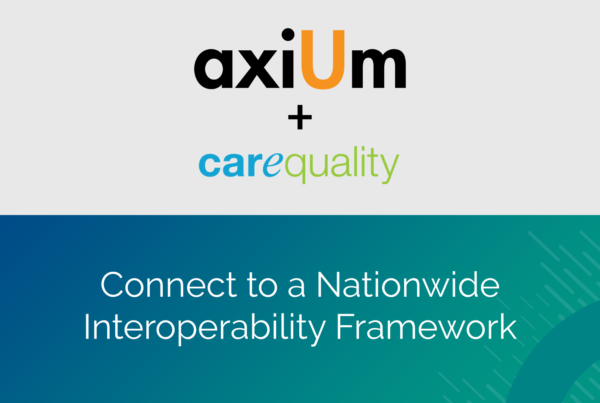Thank you to everyone who participated in our second edition of axiUm Insights. We expanded our reach this time, gathering data from 28 client databases with a focus on measuring and improving how efficiently payments are collected from both patients and insurance.
What did we learn about top-performing participants?
- Insurance gets allocated 43% faster when using EDI remittance processing. (1) (2)
- Clients who show warnings about non-covered treatments (3) see:
- Patient balances paid 34% faster.
- Patients pay in full on date of service 15% more often.
- Clients widely using linked benefit plans collect from patients 22% faster. (4)
- 25% of clients collect full payment from self-pay patients on the date of service 79% of the time.
- 25% of clients have 98% of patient payments allocated. (5)
- 25% of clients have 100% of insurance payments allocated. (6)
What did we learn about all participants?
- Insurance payments get manually allocated in 47 days. (7)
- 55% of self-pay patients pay in full on date of service. The remaining 45% take 41 days.
- 11% of patient payments are unallocated. (5)
- 2% of patient adjustments are unallocated. (5)
- 84% of A/R is collected within 3 months.
(1) Based on dollar value, past 3 months, 1 week grace given for allocations; (2) Clients contributing this data processed 82% of insurance payments electronically, based on dollar value of payments; (3) Warnings enabled for at least 25% of insurance companies (4) 25% lowest number of duplicate benefit plans, likely resulting in more accurate splits and patient communication about amount owing; (5) Based on dollar value, past 3 months of data allowing 1 day grace period for overnight payment allocations; (6) Based on dollar value, past 3 months, 1 week grace given for allocations; (7) Primary insurance, from date of service.
For our next axiUm Insights edition we are considering a focus on Patient Safety or Risk Mitigation. If you have an area of interest that you’d like to suggest for future editions, send us an email at: exancustomersuccess@henryscheinone.com.
Continue reading for ideas to implement tools and workflows that can help you to make improvements.
axiUm Insights #2: Collecting from Patients and Insurance
When collecting from patients, there are several ways to improve communication and the timeliness of receiving and allocating payments. What are the benefits? For the patient, how much they owe is clear and straightforward. The benefit to the clinic is reduced staff time and lower A/R.
The 5 main areas are:
- Know how much the patient owes
- Encourage patient payments
- Process patient payments
- Manage unallocated payments and adjustments
- Process insurance payments
Know how much the patient owes
Starting at the time of Treatment Planning through to completion of the visit, there are several areas that providers and staff can utilize to see expected and actual patient balances. By doing so, they can have financial discussions with patients and set accurate expectations. See this article for ideas on setting accurate cost expectations with patients to making that information available to both providers and staff.
Encourage patient payments
Clinics require patients to promptly pay their balances. The ideal time to collect is on the day of treatment. A clinic workflow that involves effective payment communication between patients and staff, either before or after an appointment, can provide the best opportunity to collect on the day of treatment. In addition, there are also several axiUm features and workflows which can improve payment collections from patients. Click here to learn more.
Process Patient Payments
Patient payments can be made in a variety of ways. The most typical is a manual payment made at the front desk entered in axiUm by staff. The payment is then either manually allocated to a treatment, allocated to a ‘pre-payment’ for future treatment or left unallocated. It is always best to either allocate it immediately or activate an overnight allocation process. This article provides details on how the payment allocation overnight processes work. Contact axiUm Support to turn this on.
An alternative to collecting payments is to direct your patients to pay through your bank or through a 3rd party payment system. This is often referred to as a Lockbox solution, which is a service to receive payments for organizations. These systems then periodically give you a bulk payment and payment file with the information required to import the payments into axiUm. This is done through axiUm’s Lockbox feature. It is a billable module that handles loading and processing of payment files. For pricing information or a demo, please contact axiUm Sales. Here are a few links to give you more information.
Managing unallocated payments/adjustments
Unallocated payments and adjustments can cause confusion when communicating with patients and create inaccuracies in financial reporting by practice. This article describes a few ways to improve and control the process and monitor the situation on an ongoing basis.
Process insurance payments
When a bulk insurance payment is received, funds need to be allocated to individual patient charges and often a second step is taken to indicate how to handle situations where the payment isn’t exactly as anticipated. This can be done manually within axiUm or automated with the EDI Remittance module.
Manual processing is described in detail starting on page 83 of the Transactions User Guide. This involves adding a bulk insurance payment and manually allocating the treatment it is for. It is best practice to set up defaults for how to handle Underpayments and Overpayments to speed up the work and improve accuracy. See Maintenance – Insurance Company – Settings to set up defaults.
Auto-processing can be done via the EDI Remittance module. This module allows 835 remittance files (from CHC) to be loaded into axiUm and then processed to allocate funds, auto-add claim adjustment reason codes and handle balances with configured rules for transfers and write-offs. This can save staff hours to days per insurance payment, freeing them up to work on other tasks. To learn more about this module, see these links or contact axiumsupport@henryscheinone.com for pricing information.
- EDI Remittance Module – Setup Guide
- EDI Remittance Module – User Guide
- Automating Insurance Processing Webinar This webinar discusses both EDI Processing and Insurance Eligibility Checking. The basic steps are described in the first 15 minutes.





